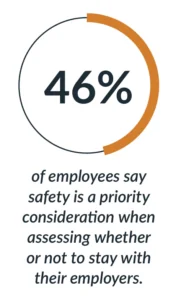
Business Resilience vs Business Continuity—A Winning Match
Business resilience and business continuity may have differences, but they should work in tandem to build a strong business. This article breaks down how and why to integrate both strategies.

Emergency preparedness and response strategies serve a common goal—protecting your people and business from the impact of unexpected events. However, there are varying schools of thought about how to best achieve that objective.
Business resilience and business continuity are often confused as competing strategies—there’s even debate about whether both strategies are necessary. But these strategies both serve different elements of your business’s emergency preparedness, and the real magic happens when you use them together.
Companies need both continuity and resilience in order to build a safe, enduring business. Leveraging aspects of both business continuity and business resilience programs enables organizations to mitigate risks more effectively and allow continuous operations. By improving your ability to respond to short-term disruptions and strengthening your long-term resilience, you’ll be prepared for whatever the future brings.
In this article, we’ll take a closer look at exactly what makes business resilience and business continuity different—and how they can complement each other to keep your business up and running during unforeseen events.
Business Resilience vs Business Continuity
There is no real competition when it comes to business resilience and business continuity, but these strategies do have their different strengths when it comes to protecting your business from harm. The main difference between these strategies is one of scope. Business resilience is aimed at long-term strength and the ability to navigate any number of disturbances and disruptions, whereas business continuity is focused on building processes and procedures to navigate a single disturbance.
What Is Business Resilience?
Business resilience is a framework integrated into a company’s culture, allowing a business to survive and even prosper in the face of challenges or crises. A resilient business is ready to adapt, flex, and pivot to changes and pressures.
The coronavirus pandemic brought the need for operational resilience into sharper focus than ever before—with 9.4 million businesses closing either temporarily or permanently. In fact, 74% of C-suite executives say they need to rethink their operating models and improve organizational resilience as a result of COVID-19.

Achieving true organizational resilience cannot be credited to a single strategy. Instead, business resilience planning and resilience management depend on a combination of major emergency planning strategies, including:
- Business continuity planning
- Crisis and risk management
- Disaster recovery management
- Incident response management
When used with an all-hazards approach, these strategies can help you absorb the effects of operational disruptions and come out the other side. Whether the disruption is a slow, incremental change or a sudden major event, you’ll be able to adjust to these new challenges and recover to become even stronger if your entire organization is resilient.
Business resiliency requires flexibility and swift decisions, which can be achieved through a combination of the following:
- A proactive approach. Leaders need to consider how to future-proof their business by anticipating disruptions and considering how they will react to them. This greatly enhances the ability of an organization to respond quickly and confidently when potentially disruptive events do occur.
- Dynamic leadership. Resilience management begins with leaders creating the right environment for agile decision-making. If resilience and adaptability are promoted from the top, the effects will trickle down to the rest of the company. Leaders also need to continuously respond to and communicate about changes, both within their industry and the world.
- Strong company safety culture. In organizations with strong safety cultures, all employees are empowered and committed to ensuring safety despite unpredictable and ever-changing risks. Leaders who truly care about their workers’ well-being foster the organization’s safety culture. This positive change requires clear goals and metrics, effective training procedures, and executives demonstrating safety as a core organizational value.
- Long-term focus. With many different challenges competing for attention right now, it can be easy to lose focus on forward planning. It might be tempting to narrow your focus to each day’s or week’s challenges, but building resilience into a company’s culture requires looking to the future and planning how to deal with any risks or disruptions it may bring.
Benefits of business resilience
Building a resilient business enables organizations to adapt quickly to new or changing conditions. And in a world where the only constant is change, resilience brings with it large-scale benefits. Organizational resilience enables companies to:
- Achieve and maintain a competitive advantage
- Enable long-term, sustainable growth
- Improve financial performance and decrease volatility
- Protect the company’s reputation
- Encourage and accelerate innovation
As a case in point, who could have predicted the enormous effect COVID-19 would have on the global economy? Well, some businesses had already implemented changes after learning the lessons from prior outbreaks of infectious diseases. The All England Lawn Tennis Club, the host of the Wimbledon tournament, took out pandemic insurance after the SARS outbreak in 2003. Other hosts of major sporting events didn’t have the foresight of Wimbledon’s leadership and lost significant investment after canceled events. With applied strategic foresight, Wimbledon was better prepared to adapt during this unprecedented public health crisis that put a stop to all public events.
Leaders often can’t predict the crises that will impact their organizations, but learning from the emergencies they do weather and putting safeguards in place for the future is a significant step toward building business resilience. Many business continuity solutions and strategies go hand-in-hand with resilience strategies to mitigate risks.
What Is Business Continuity?
Business continuity, on the other hand, is defined as an organization’s ability to continue mission-critical business functions during emergencies or unplanned disruptions—anything from natural disasters to civil unrest. To prevent and recover from risks that may impact business operations, organizations put in place processes and procedures that will allow them to maintain operations even when faced with potentially disruptive events.
Watch this step-by-step video to learn how to create and optimize a plan that ensures your operations continue running smoothly—no matter what.
In large businesses, there is usually a business continuity management (BCM) team or individual responsible for developing these guidelines and protocols. In smaller organizations, it may fall on HR to establish and communicate these protocols. But regardless of your industry or company size, every organization needs a business continuity plan (BCP) detailing the organization’s procedures in an emergency.
If your business was affected by a disruption—such as a public health crisis or severe weather event—could you continue to operate at an acceptable level? If the answer is no, or even if you’re unsure, it’s time to create a business continuity plan to ensure you can continue in the face of disruptions. Disaster recovery plans are also a foundational element of continuity planning that focus specifically on recovering critical IT systems and applications.
One of the most popular ways to build and maintain a business continuity plan is to use the Plan-Do-Check-Act (PDCA) model.
- Plan — Assess potential risks by carrying out a business impact analysis (BIA) or risk assessment. Establish critical business processes and your recovery time objective (RTO)—the maximum acceptable time before your business needs to be up and running following a disruption. By identifying and prioritizing the risks your business may encounter, your organization can develop effective mitigation strategies.
- Do — This is the stage to activate the mitigation measures you identified. Everyone in your company should know how the business continuity plan will be executed—even if they don’t need to participate in specific actions themselves. To ensure the seamless implementation of your continuity plan, it’s vital to include training sessions for the crisis management staff.
- Check — Business continuity planning isn’t a one-and-done activity. Business continuity plans are living documents that you must periodically evaluate and adjust, such as when new vulnerabilities or risks emerge or you make changes in how your business operates. Running simulated tabletop exercises is an excellent way to test your business continuity plan before a crisis occurs.
- Act — Adaptability is a critical component of any crisis response. Apply the lessons from emergency drills, tabletop exercises, and actual disruptions to identify preventive or corrective actions that can improve you preparedness. You can also use after-action reports (AARs) to pinpoint any gaps or weaknesses you need to address in your business continuity plan.
Benefits of business continuity
Developing and implementing a business continuity plan is essential to protecting your people, property, and assets. Effective business continuity planning enables organizations to:
- Maintain critical business operations during and after critical events
- Resume normal operations quickly after disruptive events
- Protect the organization from financial losses
- Ensure compliance with legal and regulatory requirements
- Enhance employee health, safety, and well-being
- Reassure employees, stakeholders, and customers that you can withstand disruptions
Business continuity plans enable organizations to continue moving forward, even in the face of unexpected challenges. When implemented effectively, these plans also help enhance the overall resilience of a business—how well your business can adapt to changing environmental, economic, and social conditions.
Why You Need Both Business Continuity and Business Resilience

Having both strategies in your preparedness toolbelt is going to give you the best possible advantage for maintaining operations and keeping people safe. Business continuity ensures organizations have the processes and protocols to continue operating in the face of specific, immediate disruptions—such as a severe winter storm, disease outbreak, or cybersecurity attack. On the other hand, business resiliency means that an organization has woven long-term agility and adaptability into the fabric of its culture. You need both targeted business continuity and general business resilience to ensure your organization is ready for whatever may come its way.
Erica Reed, Business Resiliency Analyst at Macy’s, knows firsthand how necessary this combination is. “Some of our key pillars [in our business resiliency program] are crisis management and business continuity,” she told us on an episode of The Employee Safety Podcast. “One of our goals as a team is to streamline business resiliency to create an organization that continues to grow stronger and more robust. So, we have recently onboarded a new business continuity tool that allows us to create a more central singular repository for all of our plans and risk assessments… We can then identify any weaknesses or single points of failure that might exist, and then restructure or vamp those processes or procedures to help the enterprise as a whole continue to grow more resilient.”
You need both targeted business continuity and general business resilience to ensure your organization is ready for whatever may come its way.
How to Establish Resilience and Business Continuity Simultaneously
Here are four ways you can strengthen business continuity and resilience to ensure your organization is ready to handle all the challenges it will face:
1. Build a business continuity plan
It’s impossible to build long-term resilience if your organization can’t effectively respond to short-term disruptions. Creating and implementing a business continuity plan is the first step organizations can take to build resilience and reduce any potential disruptions to the business.
While organizations can’t always prevent critical events from happening, a documented business continuity plan can help you mitigate the impact of those events on employee safety and operations. Organizations can fortify their overall business resilience and continuity by documenting the specific processes and actions to be taken before, during, and after a critical event.
2. Collaborate and obtain buy-in
Business continuity and resilience are team sports—everybody needs to be involved. Whether you have an entire group dedicated to business continuity or just one staff member, there should always be a constant feedback loop to keep everyone else within the company informed. This can be achieved through regular feedback sessions or simply letting employees know you value their ideas and would like their feedback on specific parts of your overall plan.
Empower your employees to share ideas—especially regarding measures you can take to protect their safety. Getting buy-in and feedback from your employees can help promote safer behavior overall, ultimately helping reduce health and safety risks.
It’s also important that stakeholders understand their roles and responsibilities ahead of time. In a true emergency, the last thing you want is for your people to hesitate or question what they’re supposed to do. All employees should be involved and engaged with your safety strategies so that it’s as easy as possible to execute your continuity plan if necessary.
3. Set up threat monitoring
Knowledge is power—and when it comes to business continuity and resilience, it’s important to know what you might be facing sooner rather than later. One effective way to achieve this is with threat monitoring and intelligence software to identify emerging incidents that have the potential to impact your employees and business.
Fast response times help you minimize losses and inform decision-making. Software like this also allows you to automatically send out location-based alerts and notifications to keep your employees informed and safe. This provides valuable 24/7 situational awareness, so you’re always ready to protect your employees, no matter where they are in the world.
Threat intelligence software can provide real-time, verified information about critical events near your employees, locations, or company assets. This can dramatically accelerate response times and ensure those impacted can make informed decisions. Gaining an overview of historic events can also support post-event analysis and help teams conduct more efficient risk assessments, ultimately helping organizations better anticipate and prepare for potential threats.
As business travel rebounds post-COVID, it’s also important to assess the potential threats in any location where you plan to send employees. Monitoring these risks with a threat intelligence platform is valuable to any business travel safety plan.
4. Keep safety front and center
If you’ve ever reacted to an emergency without a plan, you’ve probably felt doubt and hesitation creep in. Being unsure of what to do in a stressful situation can alter our ability to handle the situation. When protecting the safety of your employees, that’s the last thing you want. Instead, implementing a predefined emergency response plan allows you to stay in control while also protecting the health and well-being of your employees.
 Maintaining a constant state of readiness will allow you to protect employee safety without any guesswork. With emergency communication software, you can keep employees informed and connected during emergency events to ensure their health and safety. With multichannel, two-way communication, employees can quickly access critical safety information and always have a lifeline.
Maintaining a constant state of readiness will allow you to protect employee safety without any guesswork. With emergency communication software, you can keep employees informed and connected during emergency events to ensure their health and safety. With multichannel, two-way communication, employees can quickly access critical safety information and always have a lifeline.
Make safety a part of your company culture, and your business is more likely to recover better and faster from emergencies and other potentially disruptive events. With a strong emphasis on safety, you’ll also be demonstrating to your employees that their health and safety are paramount—ultimately helping you attract and retain star employees. When employees perceive that their organization cares about their safety and well-being, they are more motivated to stay with that employer, according to our 2023 State of Employee Safety Report. And only when employees feel safe and secure can they focus on performing their jobs to the best of their abilities.
Build Resilience Into Everyday Operations
Today’s dynamic risk landscape is complex and constantly changing. From geopolitical risks to natural disasters to supply chain shortages, organizations must be ready for a seemingly endless range of threats. After all, could any of us have anticipated the impact of events that changed the world forever—events like September 11 or the COVID-19 pandemic?
A comprehensive business continuity plan and the ability to bounce back quickly are both essential elements of business resilience that will help your company recover and even thrive in response to unexpected stressors. Actively integrating business continuity and business resilience techniques into your emergency planning efforts can profoundly impact employee safety, business operations, and long-term organizational success. When you build adaptability and resilience into everyday operations, you’ll be able to respond, recover, and rebound—no matter what challenges you encounter.





